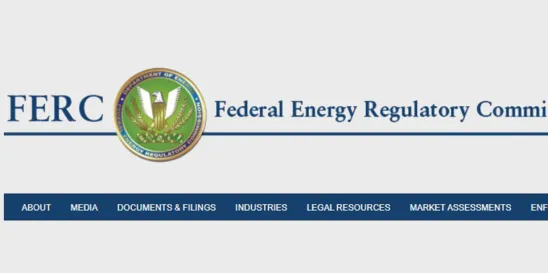On December 1, 2023, the U.S. Court of Appeals for the Third Circuit held that outcomes by operation of law caused by deadlocks among the members of the Federal Energy Regulatory Commission (FERC or Commission) are judicially reviewable as final agency action. In doing so, the Third Circuit’s decision in PJM Power Providers Group v. Federal Energy Regulatory Commission,[1] rejected three petitions seeking to overturn FERC’s acceptance of PJM Interconnection, LLC’s (PJM’s) revised Minimum Offer Price Rule (MOPR) — commonly referred to as the “Focused MOPR” — which took effect by operation of law in September 2021.
PJM Power Providers Group is the first precedential application of Federal Power Act (FPA) Section 205(g) and provides critical guidance to industry stakeholders on FERC deadlocks. In recent years, it has become more common for FERC to be comprised of four commissioners rather than the full complement of five commissioners. FERC nominees face increasing challenges during the Senate confirmation process, and the practice of pairing a Democratic nominee with a Republican nominee for that process has proved more effective than pursuing confirmation of a single FERC nominee. When a single nominee is proposed, there is frequently heavy opposition along political party lines. This backdrop can result in the fifth FERC commissioner position remaining vacant for longer periods than in the past. Having only four commissioners — two Democrats and two Republicans — increases the chance of deadlock. The FERC chairman controls the Commission’s agenda but does not have a “tie-breaking” vote.
The Third Circuit held in PJM Power Providers Group that constructive approvals resulting from a two-to-two FERC deadlock constituted approval under FPA Section 205(g), and that approval is reviewable consistent with other Commission decisions pursuant to FPA Section 205. The Third Circuit’s review included consideration of the commissioners’ written statements, issued when the Commission was unable to reach consensus on a decision within the statutory period. Section 205(g), enacted in 2018, requires each commissioner to add to the record a statement explaining their views on the matter at issue. The PJM Power Providers Group decision also affirms the implementation of PJM’s Focused MOPR. However, PJM market participants should note that PJM continues to modify its capacity market construct, which is the subject of additional proposed reforms pending before the Commission in FERC Dockets ER24-98-000 and ER24-99-000.
Background
The MOPR is a PJM market mechanism. At a high level, it is designed to prevent a market participant from offering their owned and controlled generation capacity below their cost to suppress capacity prices. On July 30, 2021, PJM filed for Commission approval of proposed revisions to its Open Access Transmission Tariff, seeking to reform the application of the PJM MOPR.[2] Specifically, PJM proposed a Focused MOPR pursuant to which only generation capacity resources of capacity market sellers with a “load interest” could be subject to the MOPR based on buyer-side market power concerns.[3] PJM’s approach relies on capacity market sellers to certify whether their generation capacity resources satisfy the PJM tariff requirements for being subject to the MOPR.[4] The reforms had the stated purpose of refocusing the MOPR on prohibiting the exercise of buyer-side market power. As PJM explained, the then-incumbent “Expanded MOPR” ignored state support for renewable resources that had become a well-established determinant of supply in the PJM region.[5] PJM’s proposed tariff changes were subject to various protests, including objections from PJM’s Independent Market Monitor, state commissions and generation developers.
When PJM filed its proposed MOPR revisions, FERC had four sitting commissioners. While five commissioners comprise FERC, a quorum only requires three, thus making it possible for four commissioners to deadlock two-to-two.[6] The Third Circuit’s treatment of this nuance makes PJM Power Providers Group a notable case. Previously, in a 2016 decision, the U.S. Court of Appeals for the D.C. Circuit held that it lacked jurisdiction over an FPA Section 205 filing that took effect after four sitting commissioners deadlocked and failed to act within the required 60-day period.[7] The D.C. Circuit reasoned that, under the FPA, the Commission did not engage in a “collective, institutional action when it deadlocked[,]”[8] and that it lacked jurisdiction under the Administrative Procedures Act (APA) because that statute only makes inaction reviewable where the agency fails to take action it is legally required to take.[9] In 2018, Congress amended the FPA to include a new provision, Section 205(g).[10] Section 205(g) states that if the commissioners deadlock two-to-two, the failure to issue an order accepting or denying the change “shall be considered to be an order issued by the Commission accepting the change for purposes of [FPA § 313(a)].”[11] Further, Section 205(g) requires each commissioner to add to the record a statement explaining their views on the matter at issue.
Pursuant to FPA requirements, the four sitting commissioners entered written statements into the record concerning PJM’s proposed MOPR changes. Then-Chairman Richard Glick and Commissioner Allison Clements, Democrats, entered a joint statement (Joint Statement) supporting PJM’s proposed tariff changes, arguing that the Focused MOPR is just and reasonable and significantly improves on the previous regime. The Joint Statement discussed at length the history of PJM’s MOPR construct and the two commissioners’ views on the changes. Republican Commissioners Mark Christie and James Danly each entered separate statements. Commissioner Christie opposed PJM’s proposal as hurried and inadequate. Commissioner Danly also opposed the PJM proposal as “irredeemably inconsistent” with the requirement that rates be just and reasonable.
The Third Circuit Case
As an initial matter, petitioners, FERC and intervenors at the Third Circuit disputed the proper scope of judicial review under FPA Section 205(g). The Third Circuit held that its review of FERC “action,” whether actual or constructive, proceeds under “the same deferential standards set forth in the FPA and [APA].”[12] Specifically, the decision concluded that the FPA directs that FERC’s factual findings be treated as conclusive if they are supported by “substantial evidence.”[13] Under the APA, a reviewing court will set aside an agency decision that is “arbitrary, capricious, an abuse of discretion, or otherwise not in accordance with law,” or that is in excess of jurisdiction or statutory authority.[14] The Third Circuit affirmed in PJM Power Providers Group that FPA Section 205(g) does not alter these standards.[15] Further, and importantly, the Court noted that its review properly encompasses the entire record, such that the statements submitted by the deadlocked commissioners are appropriately included in its review.[16]
Turning to the merits of FERC’s approval by operation of law, the Third Circuit applied Section 205(g) to construe the FERC deadlock as an affirmative order.[17] The Court found that upon consideration of the commissioners’ recorded statements, “the rationale set forth in the Joint Statement for approving the [Focused MOPR] was neither arbitrary nor capricious and was supported by substantial evidence in the record.”[18] Specifically, among other propositions, the Court found that the Joint Statement identified specific changed circumstances to support its conclusions, including a recent proliferation of state policies to influence the energy resource mix.[19] The Court disagreed with petitioners’ claims that FERC failed to consider market participants’ reliance interests and emphasized that “FERC’s authority to determine whether wholesale rates are ‘just and reasonable’ is exclusive.”[20] Finding that the Joint Statement sufficiently addressed the policy and technical implications of PJM’s proposal, the Third Circuit upheld FERC’s constructive acceptance of PJM’s Focused MOPR.[21]
[1] PJM Power Providers Grp. v. Fed. Energy Reg. Comm’n, Docket Nos. 21-3068, 21-3205, 21-3243 (3d Cir. 2023) (“PJM Power Providers Group”).
[2] PJM Interconnection, LLC, Revisions to Application of Minimum Offer Price Rule, Docket No. ER21-2582-000 (filed July 30, 2021) (“PJM Tariff Filing”).
[3] Id. at PP 23-24.
[4] Id. at P 26.
[5] Id. at P 7.
[6] 42 U.S.C. § 7171(b)(1), (e).
[7] Public Citizen, Inc. v. Fed. Energy Reg. Comm’n, 839 F.3d 1165, 1170 (D.C. Cir. 2016).
[8] Id.
[9] Id. at 1172.
[10] 16 U.S.C. § 824d(g)(A).
[11] Id. § 824(g)(B).
[12] PJM Power Providers Group, at 13.
[13] 16 U.S.C. § 825l(b).
[14] 5 U.S.C. § 706(2).
[15] PJM Power Providers Group, at 32.
[16] Id. 40.
[17] Id.
[18] Id.
[19] Id. at 44.
[20] Id. at 48 (citing California ex rel. Lockyer v. FERC, 383 F.3d 1006, 1011 (9th Cir. 2004) (quoting Miss. Power & Light Co. v. Mississippi, 487 U.S. 354, 371 (1998)).
[21] Id. at 49.






 />i
/>i

